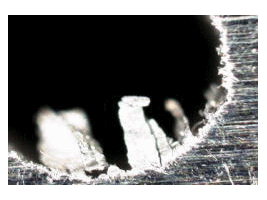1-31-1 Yokoyamadai,
Chuo-ku, Sagamihara City,
Kanagawa pref. 2520241
- Cotnact
- +81-42-7117721
Features of ultrasonic deburring cleaning
- For customers who have problems with deburring.
- Ultrasonic deburring has many features that differ from conventional methods.
Ultrasonic deburring is a completely new technology and has features not found in conventional deburring. We will consider it while comparing it with other deburring methods. In addition, it is often used in conjunction with conventional deburring methods. So, how much deburring is possible in terms of size and thickness? It may sound a little rough, but we think it is safe to say that most of the burrs can be removed by using an ordinary toothpick and poking it vertically until the toothpick breaks or the tip is crushed. For your consideration. Please use it as a reference. In fact, it is more than that.
Comparison with shot blasting
In contrast, ultrasonic deburring processes large quantities of complex shapes and composite parts at a time, usually with water, so there is no risk and no waste from the deburring process. Of course, no cleaning is required in the post-process. However, for thick-walled burrs, shot deburring is superior. Ultrasonic is used for precision microdeburring. Thickness and surface modification (although some say ultrasonic is also possible) can be classified as shot.


Comparison with Barrel Finishing

An improved version of this system is the magnetic barrel. It is less polluting and does not require wastewater treatment. However, it still has the basic features of barrel finishing. Basically, it is difficult to reach the inner surface of the workpiece. Of course, it is not suitable for magnetic materials.
Ultrasonic deburring cannot make the edge coner R. As a special case, a method that combines ultrasonic waves and abrasive grains has been put to practical use in several cases, and it has proven to be successful, but it does not provide edge control like barrel deburring. However, it is not contaminated and can be used in large quantities, and depending on the conditions, it is good at deburring fine stop holes, cross holes (not easy), and fine M2 screw holes, etc. Micro burrs at the entrance of 0.125mmΦ optical fiber connector are difficult to deburr using other methods. Ultrasonic deburring is best suited for microdeburring of complex precision parts that are difficult to deburr with a barrel, but if good results are obtained with a barrel, why not consider it as a finishing cleaning and deburring process?
Comparison with high-pressure spray
High-pressure sprays above 50㎫ are difficult to fix and involve destruction of the object. Therefore, 15㎫ to 50㎫ is a common commercially available pressure for deburring high-pressure sprays. Some high-pressure sprayers use fan-shaped or conical nozzles to secure an area instead of a straight nozzle, but this is not deburring. This is spray cleaning.
It is difficult to compare the more than 20,000 positive and negative shock waves per second of the cavity generated by ultrasonic waves with a spray in only one direction, but the 25㎫ high-pressure spray (5mmΦ sprayed vertically from a distance of 50mm) used in the paint stripping test to check deburring is more powerful than the 50㎫ spray used for the deburring test. The results are stronger than the 25㎫ spray (5mmΦ sprayed vertically from a distance of 50mm), but equal to the 50㎫ spray. Although the positive and negative shock waves of each individual cavity are admittedly much larger, the macroscopic average value is probably about this much.
High-pressure sprays have greater power and greater flushing force. Cavities are high-speed repetitive positive/negative waves, which diffuse minute contaminants but do not have the same washing power as a spray. However, the irradiated area of a high-pressure spray is as small as 5 mmΦ per nozzle when deburring, whereas even the smallest 1200 w ultrasonic wave covers an area of 300 mm✕200 mm. Also, like barrel and shot blasting, high-pressure spray tends to bend and stick burrs in one direction, making them appear to be removed, but in fact making them more difficult to remove. Burrs deep in a small stop hole are pressed rather than removed. The most significant feature of ultrasonic waves is that the negative shock wave is greater, i.e., it raises fallen objects and pulls off and removes burrs that have been crushed.
Of course, unlike high-pressure ultrasonic waves, the workpiece does not need to be secured, and even small precision parts can be processed at once. Today, the process is being used for automobile valve bodies, transmission gears, hydraulic equipment rotors, and other parts that were once thought to be impossible only with or even with high pressure. The technology is improving rapidly and seems to be stabilizing after 50㎫. The use of the new technology is expanding from the deburring of electronic parts, computer parts, etc. to the deburring of machined parts.
The most important differences are that maintenance is easy, no special pumps are used, it takes up less space, and it requires much less electricity.
[Of course, this ultrasonic deburring technology is unique to our company and is based on the SHIBANO theory. It is not applicable to ultrasonic waves in general. Just to be sure.]
Comparison with thermal debarking
Explosion of gunpowder or gas in a sealed pressure vessel to remove burrs by the pressure and high heat. This is a bold idea that leaves a lasting impression. It is mainly used to remove burrs from engine blocks and hydraulic equipment. Rather than removing burrs by force, the process uses high heat to melt and fuse the burrs. The problem is that the high heat burns the surface, and the product requires acid cleaning, followed by alkaline neutralization and rinse cleaning. Also, the target market is limited. Electronic parts, composite parts, rubber, and plastics cannot be used. The biggest drawback is the need to control explosives and gases, which makes it difficult to introduce. The price is extremely high.
Ultrasonic deburring requires no post-processing, is not dangerous, and can be easily handled by anyone. The impact force is surpassing that of thermal deburring. It can be considered as an alternative to ultrasonic deburring except for a few cases.
Comparison with Cold Barrel
It is an advanced type of barrel finishing and is used in combination with shot to deburr rubber. It is used at minus 80 degrees Celsius or lower. It is a unique tool for deburring rubber and other materials. Of course, ultrasonic cleaning is necessary after deburring. Since shots are also used, it is also necessary to remove shot material that has penetrated into narrow gaps and stop holes. Ultrasonic cold deburring is under development.
Comparison with brushes, bamboo spatulas, etc.
One of the most widely used methods today. Mainly manual. Uneven quality and a source of smaller burrs called secondary burrs. Ultrasonic deburring can replace many of these. It also eliminates the need for cleaning.
Comparison with electrolytic deburring
The burrs are removed by discharging electricity between the burrs and the electrodes in thick salt water and melting them with the heat of the electric current. This method is increasingly becoming less and less popular due to the generation of hexavalent chromium in stainless steel, treatment of salt water, treatment of heavy metals, electrode management, and above all, the short life of the equipment due to the salt. Ultrasonic deburring can replace most of these problems.
Summary of ultrasonic deburring features
Ultrasonic deburring has many features not found elsewhere.
- Any material can be used.
- Metals, plastics, rubber, ceramics, glass, and their composites. Although there are some difficulties, basically most materials can be used.
- It is not restricted by shape, the location of burr generation is multi-directional, and tolerance holes on the inner surface are also covered.
- Unlimited number of pieces. From one to tens of thousands can be processed at a time or in sequence.
- No hazardous materials, etc., are generated. No hazardous materials are used. Use water.
- Burrs can be removed while cleaning without contaminating the cleaned material. Precision cleaning is possible.
- No special technology or skills are required to use it. It is also easy to automate and manage.
- The greatest advantage is that micro burrs (micron size) can be removed more quickly and reliably. This is the only means available for future precision machining.
- Fewer consumables, e.g. filters. Small running costs.
- The cost of the equipment is a sales strategy issue, as it is the only one of its kind, but in any case, the system is far less expensive than other competing methods that require precision ultrasonic cleaning after deburring.
- Drying can also be done in a line. Suitable for processing of precision parts.
- The above advantages mean that they can be installed in a clean room or other environment and do not require isolated deburring and cleaning rooms like other means, reducing administrative costs.
All rights reserved.